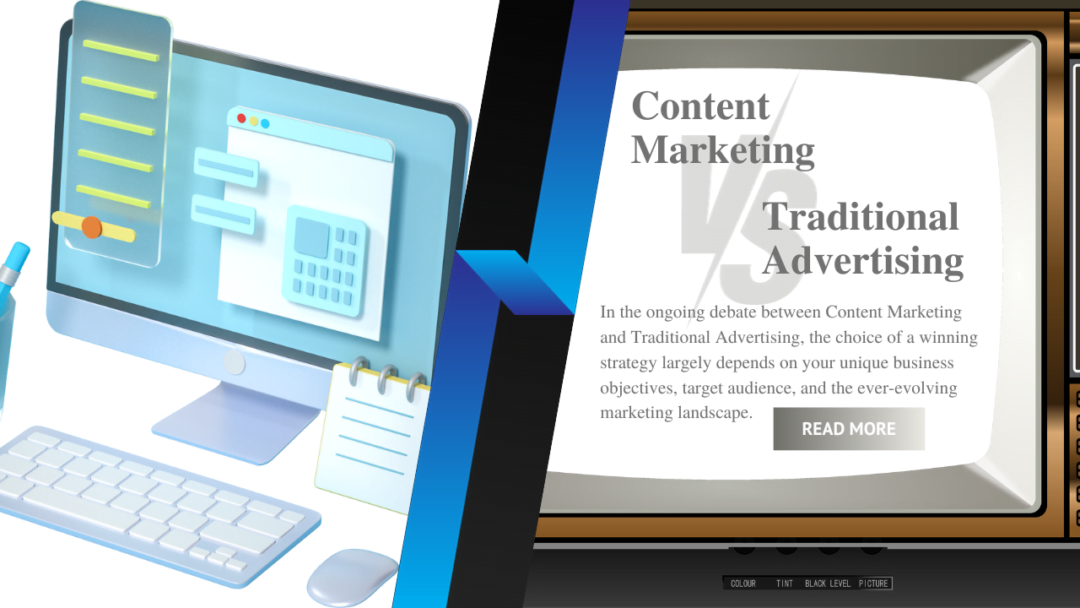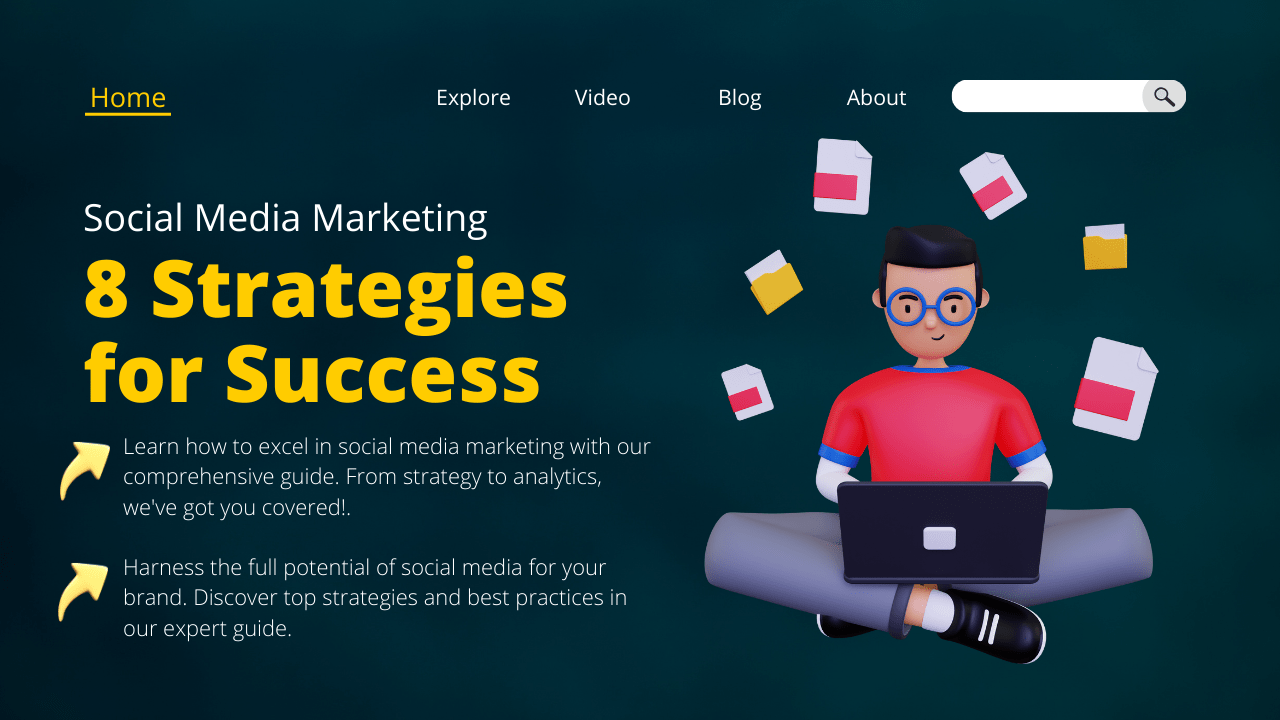Content Marketing Trends vs. Traditional Advertising
In the dynamic realm of marketing, the ongoing battle between Content Marketing Trends and Traditional Advertising holds great significance. Every day, businesses grapple with the pressing question of which strategy will best capture their target audience’s attention and convert it into loyal customers. This blog post endeavors to unravel the intricate details of these two marketing giants and provide you with a comprehensive understanding, enabling you to make well-informed decisions for your marketing campaigns.
The marketing landscape has transformed dramatically in recent years, primarily due to the advent of digital technology and the ever-increasing influence of the internet. With the evolution of consumer behavior and the emergence of new channels, it’s more crucial than ever for businesses to adapt their marketing strategies for optimal results. Content Marketing and Traditional Advertising represent two distinct, yet highly relevant, approaches in this modern marketing ecosystem.
Content Marketing: The Art of Storytelling
Content marketing, a relatively novel approach, revolves around the creation and dissemination of valuable, informative, and engaging content. Unlike the overt promotional nature of traditional advertising, content marketing seeks to establish a meaningful connection with the target audience by telling a story, educating, and entertaining. It’s about providing value to your audience first, with the expectation that they will reciprocate through brand loyalty and, ultimately, purchases.
The heart of content marketing is the power of storytelling. Businesses utilize blog posts, articles, videos, podcasts, and social media to share their narratives, aiming to resonate with their audience’s desires, needs, and aspirations. By delivering solutions, insights, or even just a good laugh, content marketing builds trust and loyalty, turning consumers into brand advocates.
Traditional Advertising: Adapting to the Digital Age
On the flip side, traditional advertising, which once dominated through TV, radio, print, billboards, and direct mail, has adapted and extended its reach into the digital realm. While content marketing often takes time to show its impact, traditional advertising seeks quick results by reaching a broad audience through paid promotions.
Traditional ads leverage visually appealing graphics and persuasive ad copies to capture attention and drive immediate action. They often come with high upfront costs but offer the advantage of establishing brand recognition rapidly. Furthermore, traditional advertising remains effective for time-sensitive promotions and major branding campaigns.
As we delve into this content marketing versus traditional advertising showdown, it’s essential to keep in mind that the effectiveness of each approach depends on various factors, including your specific business goals, target audience, budget, and the nature of your products or services. The ultimate winner may very well be a fusion of both strategies that adapts, innovates, and continually measures success in the ever-changing landscape of marketing.
Throughout this blog post, we will explore the nuances of content marketing and traditional advertising, weigh their respective strengths and weaknesses, and provide insights into measuring success through Key Performance Indicators (KPIs). In addition, we will discuss the latest trends in both fields and offer a glimpse into the future of marketing, giving you the tools and knowledge needed to navigate the ever-evolving marketing landscape successfully.

Understanding Content Marketing Trends
Content marketing is not just a marketing strategy; it’s a storytelling art that holds the potential to deeply connect with your audience. In this section, we will dive into the intricacies of content marketing, defining what it is and why it has become an integral part of modern marketing strategies.
The Essence of Content Marketing
At its core, content marketing involves the creation and distribution of valuable, relevant, and consistent content with the primary aim of attracting and engaging a specific target audience. Unlike traditional advertising, content marketing isn’t about pushing products or services onto consumers. Instead, it’s a pull strategy, where the focus is on providing information, solutions, entertainment, or inspiration that genuinely enriches the lives of your audience.
The key elements of content marketing include:
1. Storytelling: Content marketing is essentially storytelling. It’s about weaving narratives that resonate with your audience. These narratives can take various forms, from blog posts and videos to podcasts and social media updates. By sharing compelling stories, you create a connection with your audience and foster emotional engagement.
2. Connection and Trust: Content marketing is designed to build trust and credibility. It’s about becoming a trusted source of information in your niche. When you consistently deliver valuable content, you establish yourself as an authority, which encourages consumers to turn to your brand when making purchasing decisions.
3. Education and Empowerment: Content marketing often seeks to educate the audience. By providing knowledge, insights, and answers to their questions, you empower consumers to make informed choices. This fosters a sense of appreciation and trust.
4. Consistency: Content marketing requires a consistent effort. Success is not achieved through a one-off campaign but through an ongoing commitment to creating and sharing content that aligns with your brand’s values and resonates with your audience.
How to Implement Content Marketing
To successfully implement content marketing, consider the following steps:
1. Develop a Content Calendar: Consistency is key in content marketing. Develop a content calendar that outlines what content will be created and when it will be published. This ensures you have a steady stream of content to engage your audience.
2. Create High-Quality Content: Quality should always take precedence over quantity. Invest in content that is well-researched, well-written, and visually appealing. High-quality content is more likely to be shared and appreciated by your audience.
3. Leverage SEO: Search Engine Optimization (SEO) is critical in content marketing. By optimizing your content for search engines, you increase your visibility to potential readers. This includes using relevant keywords, creating meta descriptions, and optimizing images.
4. Multi-Platform Sharing: Don’t limit your content to just one platform. Share it on various digital platforms, including your website, social media, email marketing, and other distribution channels relevant to your target audience.
Innovation and adaptability are crucial. Keep a close eye on industry trends, analyze the performance of your content, and be prepared to adjust your strategy as needed to keep your audience engaged and inspired.
The world of content marketing is vast and dynamic, offering endless opportunities for businesses to connect with their audience. By mastering the art of storytelling and consistently delivering valuable content, you can establish a loyal following that not only appreciates your brand but becomes its advocate. Content marketing, when done right, can be a powerful tool in your marketing arsenal.

Traditional Advertising in the Digital Age
Traditional advertising, which historically thrived through mediums like television, radio, print, billboards, and direct mail, has undergone a remarkable transformation to adapt to the digital age. In this section, we’ll explore the evolution of traditional advertising, its relevance today, and how businesses can harness its power in the digital realm.
The Evolution of Traditional Advertising
Traditional advertising’s roots can be traced back to a time when newspapers, radio, and television were the primary means of mass communication. Print ads, radio jingles, and TV commercials were the mainstay for brands seeking broad exposure. However, with the rise of the internet and digital technology, traditional advertising has had to reinvent itself to stay relevant.
The Digital Age Makeover
Traditional advertising has not disappeared; rather, it has found new life online. In the digital age, traditional advertising includes:
1. Paid Online Advertising: Traditional ads have migrated to digital platforms, with options like Google Ads, Facebook Ads, and display advertising on websites like ShareASale. These digital platforms allow businesses to target specific demographics and reach a global audience.
2. Visual Appeal: Visual elements remain key to traditional advertising’s effectiveness. In the digital realm, this translates into creating eye-catching graphics, compelling ad copy, and engaging multimedia content that captures the audience’s attention.
3. Data-Driven Decision Making: In the digital age, traditional advertising leverages data analytics to measure the performance of ad campaigns. Businesses can track metrics like click-through rates, conversion rates, and engagement to refine their advertising strategies.
4. Integration with New Media: Traditional advertising integrates with newer forms of media. For example, influencer marketing has gained prominence, where social media influencers endorse products and services to their followers, often blurring the lines between traditional advertising and content marketing.
How to Implement Traditional Advertising in the Digital Age
To effectively implement traditional advertising in the digital age, consider the following steps:
1. Choose the Right Digital Channels: The key to success is selecting the right digital platforms to target your specific audience. Conduct thorough market research to identify where your potential customers spend their online time.
2. Design Eye-Catching Visuals and Copy: Visual appeal remains paramount. Create compelling visuals, videos, and ad copies that resonate with your audience’s desires and needs. This is where traditional advertising’s knack for storytelling comes into play.
3. Market Research: Invest in market research to understand your audience’s preferences, behaviors, and pain points. This data informs your advertising strategy and helps you tailor your messaging for maximum impact.
4. Data Analytics: The digital realm provides a wealth of data. Use data analytics tools to track your ad campaigns’ performance. Analyze key metrics such as impressions, click-through rates, and conversions to refine your strategies continually.
Traditional advertising in the digital age offers numerous advantages, including the ability to reach a vast online audience swiftly and the opportunity to establish brand recognition. It is particularly effective for time-sensitive promotions and brand awareness campaigns.
However, it’s important to note that the digital landscape is highly competitive, and consumers are more discerning than ever. Successful traditional advertising in the digital age requires creativity, precise targeting, and data-driven insights. When done right, it can be a powerful complement to content marketing and other modern marketing strategies, helping businesses capture the attention of a global audience in a digitally connected world.

Pros and Cons
The decision to use either Content Marketing or Traditional Advertising depends on various factors, and understanding the pros and cons of each approach is vital. In this section, we’ll delve into the advantages and disadvantages of both strategies, offering insights to help you make an informed choice for your marketing campaigns.
Pros of Content Marketing
1. Strong Audience Engagement:
- Pro: Content marketing excels at engaging the audience on a deep and meaningful level. By providing valuable, relevant content, you can create a loyal and dedicated following.
- Con: Building this level of engagement takes time and consistent effort. It’s a long-term strategy that requires patience.
2. Builds Brand Credibility:
- Pro: Content marketing establishes your brand as a trusted source of information. When you consistently deliver high-quality content, you enhance your brand’s credibility and authority in your industry.
- Con: Gaining this credibility requires time and effort. It may take a while to see significant results.
3. Cost-Effective Over Time:
- Pro: Content marketing can be cost-effective in the long run. Once you’ve created and optimized content, it continues to work for you without incurring additional costs.
- Con: The initial investment in content creation and optimization can be significant, and it may take time to see a positive return on investment (ROI).
Pros of Traditional Advertising
1. Wide Reach in a Short Time:
- Pro: Traditional advertising is known for its ability to reach a broad audience quickly. TV commercials, radio ads, or billboards can generate significant exposure in a short span.
- Con: Achieving this wide reach often comes with substantial initial costs, making it a more substantial financial commitment.
2. Established Brand Recognition:
- Pro: Traditional advertising has a track record of creating and reinforcing brand recognition. Consistent exposure through traditional channels helps embed your brand in the minds of consumers.
- Con: Traditional advertising may not engage the audience as deeply as content marketing. It doesn’t necessarily build the same level of trust or loyalty.
3. Suitable for Time-Sensitive Promotions:
- Pro: Traditional advertising is ideal for time-sensitive promotions or events. If you need to inform a large audience quickly about a sale or an event, traditional advertising methods are well-suited for this purpose.
- Con: While it’s effective for immediate promotions, traditional advertising may not have a lasting impact or build long-term customer relationships.
Finding the Right Balance
The choice between content marketing and traditional advertising isn’t necessarily an “either/or” decision. In many cases, the most effective marketing strategy involves a combination of both. It’s essential to strike a balance that aligns with your specific business goals and target audience.
In today’s dynamic marketing landscape, adaptability and innovation are key. Successful businesses often use content marketing for long-term audience building and relationship nurturing while deploying traditional advertising for immediate and widespread brand exposure.
By understanding the pros and cons of each strategy and evaluating how they align with your objectives, you can make a well-informed decision that maximizes your marketing efforts and ultimately contributes to the growth and success of your business.

Measuring Success
Measuring the success of your marketing efforts is paramount, whether you’re employing content marketing or traditional advertising. It’s through key performance indicators (KPIs) that you gain insights into what’s working, what needs improvement, and how to refine your strategies. In this section, we’ll explore the crucial aspect of measuring success and the specific KPIs associated with both content marketing and traditional advertising.
KPIs for Content Marketing
1. Website Traffic and Engagement:
- KPI: The number of visitors to your website and how long they stay, as well as their interaction with your content.
- Significance: Increased traffic and higher engagement levels indicate that your content is resonating with your audience and driving them to your online assets.
2. Social Media Shares and Comments:
- KPI: The number of times your content is shared on social media platforms and the comments or discussions it generates.
- Significance: Social engagement demonstrates the reach and impact of your content. It reflects audience interest and participation.
3. Lead Generation and Conversion Rates:
- KPI: The number of leads generated from your content and the conversion rate of these leads into customers.
- Significance: This KPI measures how effectively your content is moving prospects through the sales funnel. High conversion rates signify strong content that converts readers into paying customers.
4. Brand Mentions and Authority Growth:
- KPI: The frequency with which your brand is mentioned or cited as an expert in your industry.
- Significance: An increase in brand mentions and authority growth signifies that your content is positioning your brand as a reputable source of information in your niche.
KPIs for Traditional Advertising
1. Impression and Reach Metrics:
- KPI: The number of times your ad is viewed (impressions) and the size of your audience (reach).
- Significance: High impressions and reach indicate that your ad has significant exposure, but it’s only the first step in measuring success.
2. Conversion Rates from Ad Clicks:
- KPI: The percentage of users who take a desired action after clicking on your ad, such as making a purchase.
- Significance: This KPI directly ties ad exposure to actual conversions. A high conversion rate suggests that your ad resonates with the audience and motivates them to act.
3. Sales Generated from Advertising:
- KPI: The revenue generated as a result of your advertising efforts.
- Significance: The ultimate goal of many advertising campaigns is to drive sales. Tracking this KPI directly connects your advertising investment to monetary returns.
4. Customer Retention Rates:
- KPI: The percentage of customers acquired through advertising who continue to engage with and purchase from your business.
- Significance: High customer retention rates are a strong indicator of successful advertising. They show that your advertising efforts not only bring in new customers but also keep them coming back.
The Role of Analytics
Effective measurement of these KPIs relies on robust analytics tools. Google Analytics, social media insights, email marketing platforms, and advertising dashboards are valuable resources for collecting and analyzing data.
Once you have a clear picture of your KPIs, it’s essential to interpret the data and make data-driven decisions. Whether you need to adjust your content marketing strategy, refine your advertising campaigns, or find the right balance between the two, your KPIs provide the guidance you need.
Remember that the marketing landscape is continually evolving, and what works today may not be as effective tomorrow. By consistently monitoring and evaluating KPIs, you can adapt your strategies to stay ahead of the curve and ensure that your marketing efforts align with your overarching business goals.

Trends and the Future
The world of marketing is in a perpetual state of evolution, driven by changes in technology, consumer behavior, and global events. Understanding the current trends and anticipating the future is crucial for staying ahead of the competition and making the most of your marketing efforts. In this section, we’ll explore the key trends shaping the marketing landscape and offer insights into what the future may hold.
Current Trends in Marketing
- Video Dominance: Video content continues to reign supreme. Short-form videos on platforms like TikTok and Instagram Reels, as well as long-form content on YouTube, are highly effective for engaging and informing audiences.
- Interactive Experiences: Interactive content, such as quizzes, polls, and AR/VR experiences, is becoming increasingly popular. It enhances user engagement and fosters a sense of participation.
- Personalization: Consumers expect personalized experiences. Tailoring content and offers to individual preferences and behavior is essential for building lasting relationships.
- Sustainability and Social Responsibility: Brands are increasingly emphasizing sustainability and social responsibility in their marketing. This aligns with the growing concern for environmental and social issues among consumers.
- Voice Search and Smart Speakers: Voice search via devices like Amazon Echo and Google Home is on the rise. Optimizing content for voice queries is a trend to watch.
- Influencer Marketing: Collaborating with influencers on platforms like Instagram and YouTube remains a powerful strategy. Authentic endorsements from influencers can strongly influence purchasing decisions.
The Future of Marketing
Looking ahead, several factors are likely to shape the future of marketing:
1. Artificial Intelligence (AI): AI will play a more significant role in marketing, enabling predictive analytics, chatbots for customer service, and content generation. AI-driven personalization will be a key trend.
2. Content Diversity: As technology advances, marketers will need to diversify content even further. Virtual and augmented reality, as well as AI-generated content, will become more prevalent.
3. Privacy and Data Regulations: Stricter data protection laws and increased consumer concern about privacy will impact how marketers collect and use customer data. Ethical data practices will be crucial.
4. Sustainability Focus: Brands will continue to emphasize sustainability and social responsibility, and eco-friendly products and practices will be significant selling points.
5. Ephemeral Content: The popularity of short-lived content, as seen on platforms like Snapchat and Instagram Stories, will continue. It creates a sense of urgency and exclusivity.
6. Social Commerce: Social media platforms are increasingly integrating shopping features, allowing users to purchase products directly. Social commerce will likely expand.
7. Video and Livestreaming Growth: Video content will remain a dominant force, with the rise of livestreaming shopping experiences and virtual events.
8. Voice and Visual Search: With the proliferation of voice assistants and improvements in visual search technology, optimizing for voice and image-based queries will be essential.
9. Customer Experience (CX): Exceptional customer experience will be the primary differentiator for brands. Providing a seamless, personalized journey will be crucial for success.
10. Regulatory Challenges: Ongoing changes in data privacy regulations and advertising rules will require marketers to stay updated and compliant.
The marketing landscape is a dynamic, ever-changing space. To succeed in the future, adaptability and staying informed about emerging trends are essential. Keep a close eye on industry developments, test new strategies, and be prepared to pivot your marketing efforts to align with the shifting demands and expectations of your audience and the broader market.
Conclusion
In the ongoing debate between Content Marketing and Traditional Advertising, the choice of a winning strategy largely depends on your unique business objectives, target audience, and the ever-evolving marketing landscape. As we conclude this exploration, we’ll sum up the key takeaways and provide guidance for finding the right path in this dynamic marketing ecosystem.
The Verdict: A Matter of Alignment
Content Marketing and Traditional Advertising each have their strengths and weaknesses. Content marketing excels in building deep audience engagement, trust, and credibility. It’s cost-effective over time and positions your brand as a valuable resource. Traditional advertising, on the other hand, offers a quick and broad reach, establishes brand recognition, and is ideal for time-sensitive promotions.
However, there’s no one-size-fits-all answer to the question of which strategy is superior. The verdict depends on how well each approach aligns with your business goals. To make an informed decision:
1. Define Your Goals: Start by clearly defining your marketing goals. Are you looking to build long-term relationships, establish brand authority, or create immediate brand exposure? Your objectives will guide your choice.
2. Know Your Audience: Understanding your target audience is crucial. Consider their preferences, behaviors, and where they spend their time. This knowledge helps you tailor your strategies effectively.
3. Leverage Data and KPIs: Continually measure the performance of your marketing efforts using key performance indicators. Data-driven decisions are essential for optimizing your strategies.
4. Be Ready to Adapt: The marketing landscape is in constant flux. Be ready to adapt and refine your strategies based on real-time feedback and industry trends.
The Power of Synergy
In many cases, the most effective approach is not an “either/or” decision, but a combination of both content marketing and traditional advertising. The balance you strike depends on your specific goals, budget, and audience.
The evolving nature of marketing in the digital age allows for creative integration. Consider using content marketing for long-term audience building, relationship nurturing, and trust development. Simultaneously, employ traditional advertising for immediate brand exposure and promotion.
In a landscape where innovation and adaptability are prized, the key to success is staying attuned to the latest trends, analyzing the performance of your strategies, and consistently measuring your success. By continuously refining your approach, you can keep your brand relevant and your audience engaged, ultimately ensuring your marketing efforts align with your overarching business goals.
The decision between Content Marketing and Traditional Advertising is not merely about winning a debate; it’s about finding the most effective strategy for your brand’s unique journey in the ever-changing world of marketing. It’s a journey that involves adaptation, innovation, and the relentless pursuit of success, making the most of the opportunities that both strategies offer in this dynamic digital age.
Key Takeaways
- It’s All About Alignment: The choice between Content Marketing and Traditional Advertising should align with your specific business goals, target audience, and the dynamic marketing landscape.
- Content Marketing’s Strengths: Content marketing excels in building deep audience engagement, trust, and credibility. It’s cost-effective over time and positions your brand as a valuable resource.
- Traditional Advertising’s Advantages: Traditional advertising offers a quick and broad reach, establishes brand recognition, and is ideal for time-sensitive promotions.
- The Power of Synergy: In many cases, the most effective marketing strategy is a blend of both content marketing and traditional advertising, striking a balance that suits your objectives and audience.
- Data-Driven Decision-Making: Continually measure the performance of your marketing efforts using key performance indicators (KPIs) and leverage data to adapt and optimize your strategies.
FAQs
1. Is content marketing or traditional advertising more cost-effective?
Content marketing is often more cost-effective over time. It involves creating and sharing valuable content, which can continue to attract and engage your audience without incurring additional costs. However, traditional advertising may require significant upfront investment.
2. How do I decide which approach is best for my business?
Your choice should be based on your specific business goals and your target audience. If you aim to build long-term relationships and brand authority, content marketing may be the better choice. If you need immediate brand exposure, traditional advertising might be more suitable.
3. Can I use both content marketing and traditional advertising together?
Yes, many businesses find success by integrating both strategies. You can use content marketing for long-term audience building and trust development while employing traditional advertising for immediate brand exposure and promotions.
4. What are some common KPIs for measuring success in marketing?
Common KPIs include website traffic, engagement, lead generation, conversion rates, social media shares, comments, brand mentions, impression and reach metrics, conversion rates from ad clicks, sales generated from advertising, and customer retention rates.
5. How do I stay updated in the ever-changing marketing landscape?
Staying updated involves regularly monitoring industry trends, analyzing the performance of your strategies using data and KPIs, and being prepared to adapt and refine your approach based on real-time feedback. Consistent measurement and data-driven decision-making are essential to success in the dynamic world of marketing.
Photo by Unsplash

















